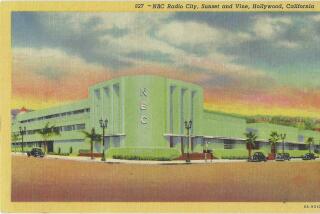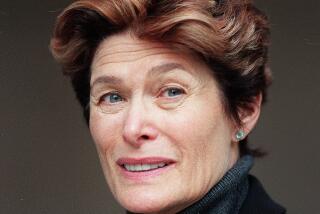Many still tuning in to ‘WKRP in Cincinnati’
- Share via
Time was, in Los Angeles radio, you got fired for saying “booger” on the air. DJ Johnny Caravella found that out, but also found redemption 25 years ago this week, when he helped transform a dysfunctional station playing nursing-home ads and elevator music, and floundering at the bottom of the ratings.
“WKRP in Cincinnati” premiered Sept. 18, 1978, with Howard Hesseman, playing Caravella -- a.k.a. Dr. Johnny Fever -- replacing the “Hallelujah Tabernacle Choir” with Ted Nugent, and giving viewers the chance to cheer an idealized glimpse of a format change. During its four-year run on CBS, the series didn’t burn up the ratings, but it did etch memorable lines, scenes and characters in the minds of fans, both inside and outside the industry it spoofed.
“Everybody listened to the radio. I thought it would be fun for them to see where the sound was coming from,” said series creator Hugh Wilson.
“We tried to make it as real as we could,” he said. “The whole time we were on the air, the nicest letters we got were from people who worked at radio stations, especially small, screwed-up radio stations. Apparently we hit a chord with them.”
They recognized the show’s characters: program director Andy Travis, good-naturedly trying to turn WKRP around; Arthur Carlson, the general manager struggling to keep his wits and his station together; sales manager Herb Tarlek, a frustrated Don Juan; news director Les Nessman, clumsy and conspiracy-minded; receptionist Jennifer Marlowe, the whip-smart bombshell; assistant Bailey Quarters, shy, earnest and quietly sexy; Venus Flytrap, the stylish yet grounded nighttime DJ, and Fever, a lovable burnout at the bottom of a career slide that began when he was fired from a top L.A. station.
“I just loved the show, and the characters really spoke to me. It resonated with me as having a level of truth to it I had never seen before,” said Steve Marshall, who worked on the series as a writer, story editor and producer, but before that had jobs at several L.A. radio stations, finally as programmer at then-KNX-FM (93.1), which he said was the first station in the country with a format now called “soft rock.”
And though viewers who toiled in radio quibbled with some technical aspects -- insisting disc jockeys couldn’t really work without headphones, for instance, while the actors said they couldn’t work with them -- the industry generally embraced the show.
“It was always, ‘We’ve got a program director just like Andy.’ ‘Absolutely, Herb Tarlek is our sales manager.’ ‘I worked with a guy just like that,’ ” Hesseman said.
They didn’t have analogues for all the personalities, however. “The two women were fantasy characters for most stations,” he said.
Wilson said the series was “kind of an orphan” on the network, and got bounced to about 12 time slots, most successfully for the few months it was on after “MASH.”
“One week we were No. 1. A lot of weeks we were 37th,” he said. “The people I run into think it was much bigger. Now it seems like it was huge,” based on the memories and fondness people have for the show when he talks to them, Wilson said.
Wilson worked as a writer for “The Bob Newhart Show” and “The Tony Randall Show,” both from Mary Tyler Moore’s MTM Enterprises. When MTM president Grant Tinker asked Wilson for show ideas, “it sort of jumped into my head that a failed rocker might be good.”
He drew on memories of his time working with radio stations as an advertising sales executive in Atlanta.
He returned there for a week and hung out with friends at rock station WQXI, “trying to beat war stories out of them.”
“WKRP” now appears in the lineup of vintage programs on Viacom’s TV Land cable network, airing Saturdays and Sundays at 12:30 a.m. Paul Ward, the network’s senior vice president of communications, said the program has averaged about 525,000 viewers per airing, a 15% increase over what ran in the same time slot a year ago, “Perfect Strangers.”
“I’m delighted there’s still some interest in it,” said Wilson, who now lives on a farm in Virginia. “When I meet people I’ve never met before, and they quote lines back to me I’ve written, and we’re both laughing -- it’s the best.”
Marshall said the show hit its apex of popularity in syndication, and he runs into people who tell him they went into the business because of WKRP. “The whole world of radio just seemed so fun and engaging, they went in that direction.”
Hesseman said he’s heard the same thing: “ ‘You’re the reason I’m in radio.’ What can I say? ‘You have my condolences. I hope it’s working for you.’ Radio is such a tortured beast right now. Along with anything that might involve some artistry or personal expression, it’s being throttled.”
With corporate chains now controlling radio stations nationwide, and individual, local owners all but gone, “the world of WKRP doesn’t exist anymore,” Marshall said.
Now, Hesseman said, “I couldn’t imagine a radio station of any size, in any market, running that way. It’s all pre-digested and all laid out.”
Which is a far cry from Hesseman’s own brief radio experience, working Saturdays in the late 1960s at San Francisco’s KMPX. He was hired by his friend, legendary programmer Tom Donahue, creator of the underground, progressive FM format, which he later brought to KMET and KPPC in the Southland. For Hesseman, it was a temporary gig: “I had no ambitions as a disc jockey, and whatever audience I had was grateful for that.”
Part of Hesseman’s enthusiasm for the Johnny Fever character was having “that whole great catalog of music to dive into.”
“For me, the music was the ninth character,” he said. “It was really exciting for me to find the right music for my sequences in the booth.”
Wilson said he thought it was imperative to use real songs to lend authenticity. Ironically, that not only changed the way the show sounded but also how it looked. The producers videotaped the series instead of shooting on film, unlike most MTM productions, because the music royalties were higher for songs on film.
“If I used a Pink Floyd record, I would get it for half than if we weren’t on tape,” Wilson said.
But that “ninth character” is missing from most of the episodes airing now. Because the song licenses weren’t perpetual, and now would cost too much to renew, Marshall and Wilson said the show’s distributor replaced the authentic cuts with generic rock, or sound-alike tunes, and even overdubbed some references to songs.
“I think it really brings the series down a notch,” Marshall said.
Hesseman said several cast and crew members still meet a few times a year, and he called the time he spent on WKRP “better than I thought it ever could be in television.”
“I get a lot of recognition, a lot of people holding children saying they grew up watching me. And I’m looking around for my walker,” Hesseman joked. “I’m glad that people still like it. It was really terrific, a deeply swinging experience.”
More to Read
The complete guide to home viewing
Get Screen Gab for everything about the TV shows and streaming movies everyone’s talking about.
You may occasionally receive promotional content from the Los Angeles Times.






